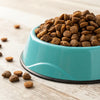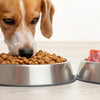Can I Mix Raw Food and Kibble for Dogs? Exploring the Benefits and Best Practices
- Houndsy
Table of Contents
- Introduction
- Understanding Raw Food and Kibble
- The Benefits of Mixing Raw Food and Kibble
- Common Myths About Mixing Raw Food and Kibble
- How to Mix Raw Food and Kibble Safely
- Conclusion
Introduction
As loving pet owners, we often find ourselves pondering the best dietary options for our furry companions. In fact, a recent survey revealed that over 80% of dog owners are concerned about their pets' nutrition. This brings us to a popular question: can I mix raw food and kibble for dogs? With the rise of raw food diets and the convenience of kibble, many of us are intrigued by the potential benefits of combining these two feeding styles.
In this blog post, we will explore the ins and outs of mixing raw food with kibble, discussing the advantages, potential risks, and strategies for a successful transition. By the end of this article, you will have a comprehensive understanding of how to create a balanced diet for your dog that incorporates both raw food and kibble, while also maintaining their health and well-being.
We will delve into the nutritional profiles of both feeding methods, debunk common myths, and provide practical tips for pet parents who wish to explore this hybrid approach. So, let's embark on this journey together and discover how we can enhance our pet's feeding experience!
Understanding Raw Food and Kibble
What is Raw Food?
Raw dog food diets typically consist of uncooked meat, bones, organs, and sometimes fruits and vegetables. Proponents of raw feeding argue that this diet mimics what dogs would naturally consume in the wild. Raw food is often praised for its high protein content, healthy fats, and the absence of fillers and artificial ingredients commonly found in commercial kibble.
What is Kibble?
Kibble, or dry dog food, is a highly processed form of pet food made from a mixture of grains, proteins, fats, and other nutrients. While kibble is convenient and shelf-stable, it often contains preservatives, fillers, and artificial flavors. High-quality kibble can still provide a balanced diet, but it may lack some of the nutritional diversity found in raw foods.
Nutritional Profiles
-
Raw Food Benefits:
- High protein and fat content
- Minimal processing and fewer additives
- Promotes healthy skin and coat
- Supports dental health through chewing raw bones
-
Kibble Benefits:
- Convenient and easy to store
- Long shelf life
- Formulated to meet AAFCO standards for complete and balanced nutrition
- Cost-effective for many pet owners
Understanding the nutritional profiles of both raw food and kibble is crucial for pet owners who want to mix these diets effectively.
The Benefits of Mixing Raw Food and Kibble
1. Nutritional Variety
One of the primary advantages of mixing raw food with kibble is the opportunity to provide a more varied diet. By incorporating raw food, we can enhance the nutritional value of our dog's meals, offering a broader spectrum of vitamins, minerals, and enzymes that may be lacking in kibble alone.
2. Enhanced Palatability
Many dogs find raw food to be more appealing than kibble. Mixing raw food as a topper can entice picky eaters and make mealtime more enjoyable. The aroma and texture of raw ingredients can stimulate a dog's appetite, encouraging them to eat.
3. Improved Digestive Health
Combining raw food with kibble can support better digestion. Raw foods are rich in natural enzymes and probiotics, which can aid in breaking down food and improving gut health. This is particularly beneficial for dogs that may have sensitive stomachs or digestive issues.
4. Cost-Effectiveness
Feeding purely raw can be expensive, especially for larger breeds. By mixing raw food with high-quality kibble, we can create a balanced diet that is more budget-friendly. This hybrid approach allows us to provide the benefits of raw food without the high costs associated with an exclusively raw diet.
5. Flexibility and Convenience
Mixing raw food and kibble offers flexibility in meal planning. We can easily adjust the ratio of raw to kibble based on our schedules, availability, and budget. This adaptability makes it easier for us to maintain a consistent feeding routine while accommodating our dog's needs.
Common Myths About Mixing Raw Food and Kibble
Despite the benefits, there are several myths surrounding the practice of mixing raw food and kibble. Let’s address some of these misconceptions.
Myth 1: Dogs Can't Digest Both
One prevalent myth is that dogs cannot properly digest raw food and kibble together. However, studies have shown that dogs are capable of digesting a variety of food types simultaneously. Their digestive systems are well-equipped to handle different nutrients, provided we introduce changes gradually.
Myth 2: Mixing Causes Digestive Upset
Many pet owners worry that mixing raw food with kibble will lead to gastrointestinal issues. While sudden changes in diet can cause upset stomachs, a gradual transition allows a dog's gut bacteria to adapt effectively. This can be achieved by slowly incorporating raw food into their meals.
Myth 3: Raw Food and Kibble Have Different Digestion Rates
Another misconception is that raw food and kibble digest at different rates, leading to digestive complications. While it is true that raw food typically digests more quickly due to its moisture content, dogs can manage this difference without issues, especially when the foods are combined thoughtfully.
How to Mix Raw Food and Kibble Safely
1. Start Slowly
When introducing raw food into your dog's diet, it is essential to start slowly. Begin by mixing a small amount of raw food with their regular kibble, gradually increasing the ratio over several days. This allows their digestive system to adjust without overwhelming it.
2. Monitor Your Dog's Response
As we transition to a mixed diet, we should closely monitor our dog's health and behavior. Look for signs of digestive upset, such as vomiting or diarrhea, and consult with a veterinarian if any concerns arise.
3. Consider Nutritional Balance
It is important to ensure that the overall diet remains balanced. When mixing raw food and kibble, we should aim for a ratio of 25-50% raw food to achieve the desired nutritional benefits. Working with a veterinarian or pet nutritionist can provide valuable guidance.
4. Maintain Portion Control
Whether we are feeding raw, kibble, or a combination of both, portion control is crucial. Each dog's nutritional needs will vary based on factors such as age, size, activity level, and health status. Adjusting portion sizes accordingly will help prevent overfeeding or undernourishment.
5. Utilize High-Quality Ingredients
When selecting kibble to mix with raw food, choose high-quality options that prioritize natural ingredients and avoid fillers. Premium brands often provide better nutritional profiles, complementing the benefits of raw food.
Conclusion
Mixing raw food and kibble for dogs can be a rewarding way to provide a balanced diet that caters to our pets' nutritional needs. This hybrid approach offers numerous benefits, including enhanced palatability, improved digestive health, and cost-effectiveness. By debunking myths and following practical tips for safe mixing, we can create a feeding routine that our dogs love and thrive on.
As we navigate our pets' dietary choices, let’s remember that each dog is unique, and what works for one may not work for another. Always consult with a veterinarian for personalized advice tailored to your dog's specific needs.
Are you ready to elevate your dog's feeding experience? Explore our Houndsy Kibble Dispenser to make mealtime more convenient and enjoyable for you and your furry friend. Order now!
FAQ
Can I mix raw food and kibble for all dog breeds?
Yes, you can mix raw food and kibble for any dog breed. However, it is important to consider the individual dietary needs of your dog and adjust the ratio accordingly.
How much raw food should I add to kibble?
Start by adding a small amount of raw food to your dog's kibble, gradually increasing it to about 25-50%, depending on your dog's tolerance and nutritional needs.
Will mixing raw food and kibble cause digestive issues?
If introduced gradually, mixing raw food and kibble should not cause digestive issues. However, sudden changes in diet can lead to upset stomachs, so it’s important to transition slowly.
What are some good raw food options to mix with kibble?
Some great raw food options include raw meats, organs, and bones. You can also consider adding raw fruits and vegetables, but ensure they are safe and appropriate for your dog.
Should I consult a veterinarian before changing my dog's diet?
Yes, it is always advisable to consult with a veterinarian before making significant changes to your dog's diet, especially if they have specific health concerns or dietary restrictions.












